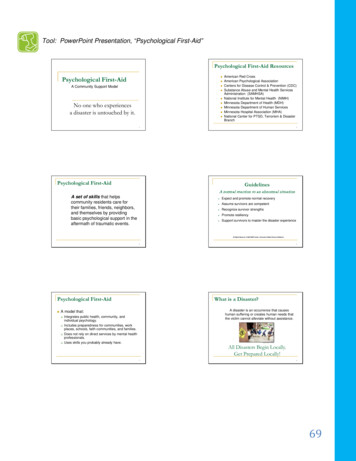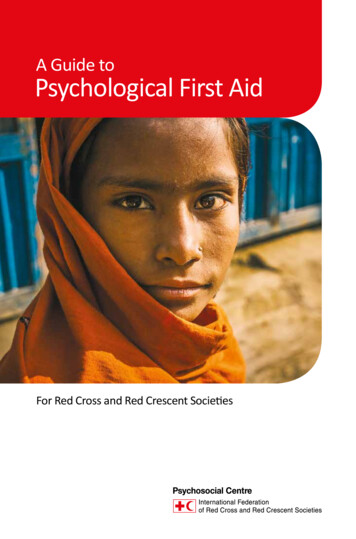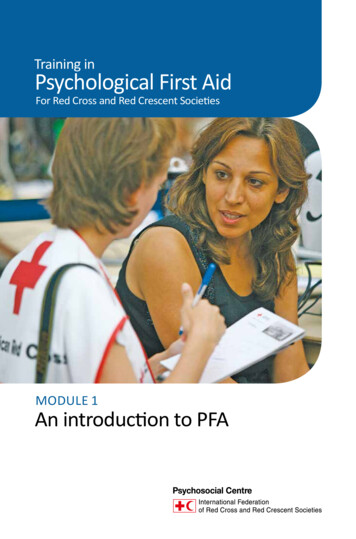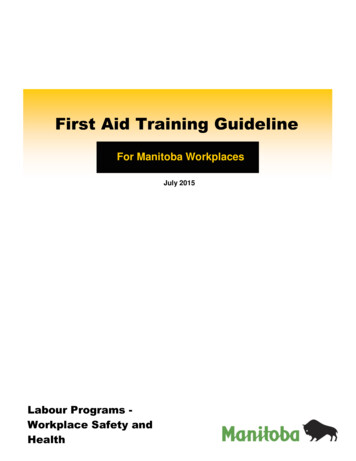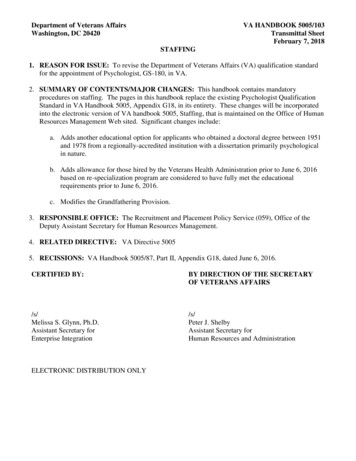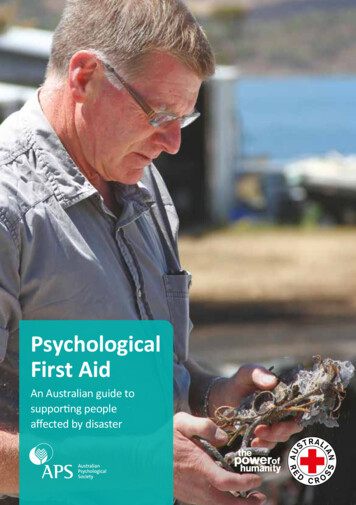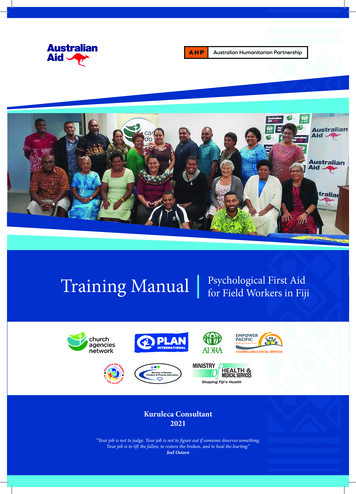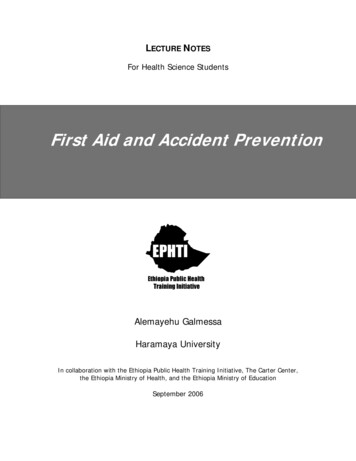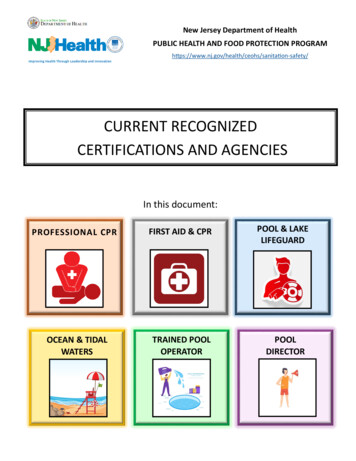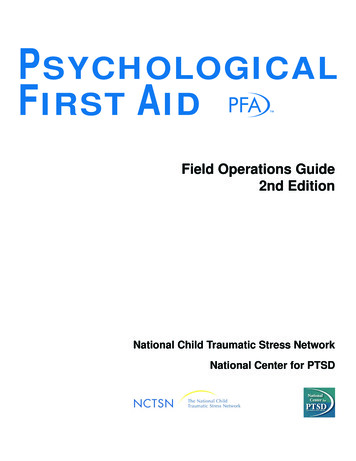
Transcription
PSYCHOLOGICALFIRST AIDField Operations Guide2nd EditionNational Child Traumatic Stress NetworkNational Center for PTSD
National Child Traumatic Stress NetworkEstablished by Congress in 2000, the National Child Traumatic Stress Network (NCTSN) is a uniquecollaboration of academic and community-based service centers whose mission is to raise the standard ofcare and increase access to services for traumatized children and their families across the United States.Combining knowledge of child development, expertise in the full range of child traumatic experiences, andattention to cultural perspectives, the NCTSN serves as a national resource for developing and disseminatingevidence-based interventions, trauma-informed services, and public and professional education.National Center for PTSDVA’s National Center for PTSD is a world leader in research and education programs focusing on PTSDand other psychological and medical consequences of traumatic stress. Mandated by Congress in 1989,the Center is a consortium of seven academic centers of excellence providing research, education andconsultation in the field of traumatic stress.The views, opinions, and content are those of the authors, and do not necessarily reflect those of SAMHSA orHHS.Copyright 2006 Brymer M, Jacobs A, Layne C, Pynoos R, Ruzek J, Steinberg A, Vernberg E, WatsonP, (National Child Traumatic Stress Network and National Center for PTSD). All rights reserved. You arewelcome to copy or redistribute this material in print or electronically provided the text is not modified, theauthors and the National Child Traumatic Stress Network (NCTSN) and National Center for PTSD (NCPTSD)are cited in any use, and no fee is charged for copies of this publication. Unauthorized commercial publicationor exploitation of this material is specifically prohibited. Anyone wishing to use any of this material forcommercial use must request and receive prior written permission from the NCTSN. Permission for such useis granted on a case-by-case basis at the sole discretion of NCTSN. If you would like permission to adapt orlicense these materials, please contact Melissa Brymer, Psy.D. at mbrymer@mednet.ucla.edu. Other inquirescan be directed to the NCTSN National Resource Center at info@nctsn.org or (919) 682-1552.
Psychological First AidTable of Core.Actions.191. Contact and Engagement .232. Safety and Comfort .273. Stabilization (if needed).494. Information Gathering: Needs and Current Concerns .575. Practical Assistance .656. Connection with Social Supports.697. Information on Coping.778. Linkage with Collaborative Services .93LIST.OF.APPENDICES:.97Appendix.A:.Overview of Psychological First Aid .99Appendix.B:.Service Delivery Sites and Settings .103Appendix.C:.Psychological First Aid Provider Care.109Appendix.D:.Psychological First Aid Worksheets .119Appendix.E:.Handouts for Survivors .125Appendix.F:.Duplicate Handouts to Copy and DistributePsychological First Aid - Field Operations GuideI
.This.page.intentionally.left.blank.
AcknowledgementsAcknowledgementsThis Psychological First Aid Field Operations Guide was developed by the National ChildTraumatic Stress Network and the National Center for PTSD. Members of the NationalChild Traumatic Stress Network and the National Center for PTSD, as well as otherindividuals involved in coordinating and participating in disaster response, have contributedto the current document.The principal authors (in alphabetical order) included: Melissa Brymer, Christopher Layne,Anne Jacobs, Robert Pynoos, Josef Ruzek, Alan Steinberg, Eric Vernberg, and PatriciaWatson.Special contributors included: Steve Berkowitz, Dora Black, Carrie Epstein, Julian Ford,Laura Gibson, Robin Gurwitch, Jack Herrmann, Jessica Hamblen, Russell Jones, RobertMacy, William Saltzman, Janine Shelby, Merritt Schreiber, Betty Pfefferbaum, RosePfefferbaum, Margaret Samuels, Cynthia Whitham, Bonita Wirth, and Bruce Young.Additional material for this Psychological First Aid Field Operations Guide was drawnfrom an adaptation by the Medical Reserve Corps (MRC). Principal authors for the MRCadaptation (in alphabetical order) included: Abbe Finn, Jack Herrmann, John Hickey,Edward Kantor, Patricia Santucci, and James Shultz. Additional content was provided bymembers of the Clergy Adaptation Group, including from Fuller Theological Seminary(in alphabetical order): David Augsburger, Cynthia Eriksson, David Foy, Peter Kung,Doug McConnell, Kathy Putnam, Dave Scott, and Jennifer Orona; from the HealthCareChaplaincy (in alphabetical order): Nathan Goldberg, George Handzo, Yusuf Hasan, MarthaJacobs, Jon Overvold, and Eun Joo Kim; and from the Adolescent Trauma TreatmentDevelopment Center of the North Shore Long Island Jewish Health System (in alphabeticalorder): Christine DiBenedetto, Sandra Kaplan, Victor Labruna, Ayme Turnbull, and JulietVogel. Additional content was also provided by the University of California, San Francisco(in alphabetical order): Chandra Ghosh Ippen, Alicia Lieberman, and Patricia Van Horn.A SAMHSA-supported expert review panel was convened on March 31-April 1, 2005.Participants made invaluable contributions. Those attending included: Miksha Nation,Cecilia Revera-Casale, Kerry Crawford, Rosemary Creeden, Daniel Dodgen, DarrinDonato, William Eisenberg, Mary Fetchet, Ellen Gerrity, Richard Gist, Ian Gordon,Susan Hamilton, Seth Hassett, Jack Herrmann, Stevan Hobfoll, Stacia Jepson, SandraKaplan, Susan Ko, Linda Ligenza, Steven Marans, Christina Mosser, April Naturale,Elana Newman, Bonnie O’Neill, Dori Reissman, Gilbert Reyes, Janine Shelby, and RobertUrsano.For citation: Brymer M, Jacobs A, Layne C, Pynoos R, Ruzek J, Steinberg A, VernbergE, Watson P, (National Child Traumatic Stress Network and National Center for PTSD),Psychological First Aid: Field Operations Guide, 2nd Edition. July, 2006. Available on:www.nctsn.org and www.ncptsd.va.gov.Psychological First Aid - Field Operations Guide
.This.page.intentionally.left.blank. National Child Traumatic Stress Network National Center for PTSD
Psychological First AidField Operations Guide2nd EditionIntroduction and Overview: What is Psychological First Aid?Who is Psychological First Aid for?Who Delivers Psychological First Aid?When Should Psychological First Aid Be Used?Where Should Psychological First Aid Be Used?Strengths of Psychological First AidBasic Objectives of Psychological First AidDelivering Psychological First Aid
.This.page.intentionally.left.blank.National Child Traumatic Stress Network National Center for PTSD
What is Psychological First Aid?Psychological First Aid is an evidence-informed1 modular approach to help children,adolescents, adults, and families in the immediate aftermath of disaster and terrorism.Psychological First Aid is designed to reduce the initial distress caused by traumaticevents and to foster short- and long-term adaptive functioning and coping. Principles andtechniques of Psychological First Aid meet four basic standards. They are:1. Consistent with research evidence on risk and resilience following trauma2. Applicable and practical in field settings3. Appropriate for developmental levels across the lifespan4. Culturally informed and delivered in a flexible mannerPsychological First Aid does not assume that all survivors will develop severe mentalhealth problems or long-term difficulties in recovery. Instead, it is based on anunderstanding that disaster survivors and others affected by such events will experiencea broad range of early reactions (for example, physical, psychological, behavioral,spiritual). Some of these reactions will cause enough distress to interfere with adaptivecoping, and recovery may be helped by support from compassionate and caring disasterresponders.Who is Psychological First Aid For?Psychological First Aid intervention strategies are intended for use with children,adolescents, parents/caretakers, families, and adults exposed to disaster or terrorism.Psychological First Aid can also be provided to first responders and other disaster reliefworkers.Who Delivers Psychological First Aid?Psychological First Aid is designed for delivery by mental health and other disasterresponse workers who provide early assistance to affected children, families, and adultsas part of an organized disaster response effort. These providers may be imbeddedin a variety of response units, including first responder teams, incident commandsystems, primary and emergency health care, school crisis response teams, faith-basedorganizations, Community Emergency Response Teams (CERT), Medical Reserve Corps,the Citizens Corps, and other disaster relief organizations.1Psychological First Aid is supported by disaster mental health experts as the “acute intervention of choice” when responding to the psychosocial needs of children, adults and families affected by disaster and terrorism. At the time of thiswriting, this model requires systematic empirical support; however, because many of the components have been guidedby research, there is consensus among experts that these components provide effective ways to help survivors managepost-disaster distress and adversities, and to identify those who may require additional services.Psychological First Aid - Field Operations Guide Introduction and OverviewIntroduction and Overview
Psychological First Aid is a supportive intervention for use in the immediate aftermath ofdisasters and terrorism.Where Should Psychological First Aid Be Used?Psychological First Aid is designed for delivery in diverse settings. Mental health andother disaster response workers may be called upon to provide Psychological FirstAid in general population shelters, special needs shelters, field hospitals and medicaltriage areas, acute care facilities (for example, Emergency Departments), staging areasor respite centers for first responders or other relief workers, emergency operationscenters, crisis hotlines or phone banks, feeding locations, disaster assistance servicecenters, family reception and assistance centers, homes, businesses, and other communitysettings. For more information on the challenges of providing Psychological First Aid invarious service settings, see Appendix B.Strengths of Psychological First Aid Psychological First Aid includes basic information-gathering techniques to helpproviders make rapid assessments of survivors’ immediate concerns and needs, andto implement supportive activities in a flexible manner. Psychological First Aid relies on field-tested, evidence-informed strategies that canbe provided in a variety of disaster settings. Psychological First Aid emphasizes developmentally and culturally appropriateinterventions for survivors of various ages and backgrounds. Psychological First Aid includes handouts that provide important information foryouth, adults, and families for their use over the course of recovery.Basic Objectives of Psychological First Aid Establish a human connection in a non-intrusive, compassionate manner. Enhance immediate and ongoing safety, and provide physical and emotionalcomfort. Calm and orient emotionally overwhelmed or distraught survivors. Help survivors to tell you specifically what their immediate needs and concerns are,and gather additional information as appropriate. Offer practical assistance and information to help survivors address their immediateneeds and concerns.National Child Traumatic Stress Network National Center for PTSDIntroduction and OverviewWhen Should Psychological First Aid Be Used?
Connect survivors as soon as possible to social support networks, including familymembers, friends, neighbors, and community helping resources. Support adaptive coping, acknowledge coping efforts and strengths, and empowersurvivors; encourage adults, children, and families to take an active role in theirrecovery. Provide information that may help survivors cope effectively with the psychologicalimpact of disasters. Be clear about your availability, and (when appropriate) link the survivor to anothermember of a disaster response team or to local recovery systems, mental healthservices, public-sector services, and organizations.Delivering Psychological First AidProfessional Behavior Operate only within the framework of an authorized disaster response system. Model healthy responses; be calm, courteous, organized, and helpful. Be visible and available. Maintain confidentiality as appropriate. Remain within the scope of your expertise and your designated role. Make appropriate referrals when additional expertise is needed or requested by thesurvivor. Be knowledgeable and sensitive to issues of culture and diversity. Pay attention to your own emotional and physical reactions, and practice self-care.Guidelines for Delivering Psychological First Aid Politely observe first; don’t intrude. Then ask simple respectful questions todetermine how you may help. Often, the best way to make contact is to provide practical assistance (food, water,blankets). Initiate contact only after you have observed the situation and the person or family,and have determined that contact is not likely to be intrusive or disruptive. Be prepared that survivors will either avoid you or flood you with contact. Speak calmly. Be patient, responsive, and sensitive.Psychological First Aid - Field Operations Guide Introduction and Overview
Speak slowly, in simple concrete terms; don’t use acronyms or jargon. If survivors want to talk, be prepared to listen. When you listen, focus on hearingwhat they want to tell you, and how you can be of help. Acknowledge the positive features of what the survivor has done to keep safe. Give information that directly addresses the survivor’s immediate goals and clarifyanswers repeatedly as needed. Give information that is accurate and age-appropriate for your audience. When communicating through a translator or interpreter, look at and talk to theperson you are addressing, not at the translator or interpreter. Remember that the goal of Psychological First Aid is to reduce distress, assist withcurrent needs, and promote adaptive functioning, not to elicit details of traumaticexperiences and losses.Some Behaviors to Avoid Do not make assumptions about what survivors are experiencing or what they havebeen through. Do not assume that everyone exposed to a disaster will be traumatized. Do not pathologize. Most acute reactions are understandable and expectable givenwhat people exposed to the disaster have experienced. Do not label reactions as“symptoms,” or speak in terms of “diagnoses,” “conditions,” “pathologies,” or“disorders.” Do not talk down to or patronize the survivor, or focus on his/her helplessness,weaknesses, mistakes, or disability. Focus instead on what the person has donethat is effective or may have contributed to helping others in need, both during thedisaster and in the present setting. Do not assume that all survivors want to talk or need to talk to you. Often, beingphysically present in a supportive and calm way helps affected people feel safer andmore able to cope. Do not “debrief” by asking for details of what happened. Do not speculate or offer possibly inaccurate information. If you cannot answer asurvivor’s question, do your best to learn the facts.National Child Traumatic Stress Network National Center for PTSDIntroduction and OverviewGuidelines for Delivering Psychological First Aid - continued
For young children, sit or crouch at the child’s eye level. Help school-age children verbalize their feelings, concerns and questions; providesimple labels for common emotional reactions (for example, mad, sad, scared,worried). Do not use extreme words like “terrified” or “horrified” because this mayincrease their distress. Listen carefully and check in with the child to make sure you understand him/her. Be aware that children may show developmental regression in their behavior anduse of language. Match your language to the child’s developmental level. Younger children typicallyhave less understanding of abstract concepts like “death.” Use direct and simplelanguage as much as possible. Talk to adolescents “adult-to-adult,” so you give the message that you respect theirfeelings, concerns, and questions. Reinforce these techniques with the child’s parents/caregivers to help them provideappropriate emotional support to their child.Working with Older Adults Older adults have strengths as well as vulnerabilities. Many older adults haveacquired effective coping skills over a lifetime of dealing with adversities. For those who may have a hearing difficulty, speak clearly and in a low pitch. Don’t make assumptions based only on physical appearance or age, for example,that a confused elder has irreversible problems with memory, reasoning,or judgment. Reasons for apparent confusion may include: disaster-relateddisorientation due to change in surroundings; poor vision or hearing; poornutrition or dehydration; sleep deprivation; a medical condition or problems withmedications; social isolation; and feeling helpless or vulnerable. An older adult with a mental health disability may be more upset or confusedin unfamiliar surroundings. If you identify such an individual, help to makearrangements for a mental health consultation or referral.Working With Survivors with Disabilities When needed, try to provide assistance in an area with little noise or otherstimulation. Address the person directly, rather than the caretaker, unless direct communicationis difficult.Psychological First Aid - Field Operations Guide Introduction and OverviewWorking With Children and Adolescents
0 If communication (hearing, memory, speech) seems impaired, speak simply andslowly. Take the word of a person who claims to have a disability–even if the disability isnot obvious or familiar to you. When you are unsure of how to help, ask, “What can I do to help?” and trust whatthe person tells you. When possible, enable the person to be self-sufficient. Offer a blind or visually impaired person your arm to help him/her move about inunfamiliar surroundings. If needed, offer to write down information and make arrangements for the person toreceive written announcements. Keep essential aids (such as medications, oxygen tank, respiratory equipment, andwheelchair) with the person.National Child Traumatic Stress Network National Center for PTSDIntroduction and OverviewWorking With Survivors with Disabilities - continued
Psychological First AidField Operations Guide2nd EditionPreparing to Deliver Psychological First Aid: Entering the SettingProviding ServicesGroup SettingsMaintain a Calm PresenceBe Sensitive to Culture and DiversityBe Aware of At-Risk Populations
.This.page.intentionally.left.blank.National Child Traumatic Stress Network National Center for PTSD
In order to be of assistance to disaster-affected communities, the Psychological First Aidprovider must be knowledgeable about the nature of the event, current circumstances, and thetype and availability of relief and support services.Planning and preparation are important when working as a Psychological First Aid provider.Up-to-date training in disaster mental health and knowledge of your incident commandstructure are critical components in undertaking disaster relief work. You may also be workingwith children, older adults and special populations, all of which require additional in-depthknowledge. In deciding whether to participate in disaster response, you should consider yourcomfort level with this type of work, your current health, your family and work circumstances,and be prepared to engage in appropriate self-care. See Appendix C for more guidance inregard to these topics.Entering the SettingPsychological First Aid begins when a disaster response worker enters an emergencymanagement setting in the aftermath of a disaster (See Appendix B for descriptions ofvarious service delivery sites). Successful entry involves working within the framework of anauthorized Incident Command System (ICS) in which roles and decision-making are clearlydefined. It is essential to establish communication and coordinate all activities with authorizedpersonnel or organizations that are managing the setting. Effective entry also includes learningas much as you can about the setting, for example, leadership, organization, policies andprocedures, security, and available support services. You need to have accurate informationabout what is going to happen, what services are available, and where they can be found. Thisinformation needs to be gathered as soon as possible, given that providing such information isoften critical to reducing distress and promoting adaptive coping.Providing ServicesIn some settings, Psychological First Aid may be provided in designated areas. In othersettings, providers may circulate around the facility to identify those who might needassistance. Focus your attention on how people are reacting and interacting in the setting.Individuals who may need assistance include those showing signs of acute distress, includingindividuals who are: Disoriented Confused Frantic or agitatedPsychological First Aid - Field Operations Guide 3Preparing to DeliverPreparing to DeliverPsychological First Aid
Panicky Extremely withdrawn, apathetic, or “shut down” Extremely irritable or angry Exceedingly worriedGroup SettingsWhile Psychological First Aid is primarily designed for working with individuals andfamilies, many components can be used in group settings, such as when families gathertogether for information about loved ones and for security briefings. The components ofproviding information, support, comfort, and safety can be applied to these spontaneous groupsituations. For groups of children and adolescents, offering games for distraction can reduceanxiety and concern after hours and days in a shelter setting.When meeting with groups, keep the following in mind: Tailor the discussion to the group’s shared needs and concerns. Focus the discussion on problem-solving and applying coping strategies to immediateissues. Do not let discussion about concerns lapse into complaints. If an individual needs further support, offer to meet with him/her after the groupdiscussion.Maintain a Calm PresencePeople take their cue from how others are reacting. By demonstrating calmness and clearthinking, you can help survivors feel that they can rely on you. Others may follow your leadin remaining focused, even if they do not feel calm, safe, effective, or hopeful. PsychologicalFirst Aid providers often model the sense of hope that survivors cannot always feel while theyare still attempting to deal with what happened and current pressing concerns.Be Sensitive to Culture and DiversityProviders of Psychological First Aid must be sensitive to culture, ethnic, religious, racial, andlanguage diversity. Whether providing outreach or services, you should be aware of your ownvalues and prejudices, and how these may agree with or differ from those of the communitybeing served. Training in cultural competence can facilitate this awareness. Helping tomaintain or reestablish customs, traditions, rituals, family structure, gender roles, and socialbonds is important in helping survivors cope with the impact of a disaster. Information aboutthe community being served, including how emotions and other psychological reactions are 4National Child Traumatic Stress Network National Center for PTSDPreparing to DeliverProviding Services - continued
Be Aware of At-Risk PopulationsIndividuals that are at special risk after a disaster include: Children, especially those: Separated from parents/caregivers Whose parents/caregivers, family members, or friends have died Whose parents/caregivers were significantly injured or are missing Involved in the foster care system Those who have been injured Those who have had multiple relocations and displacements Medically frail children and adults Those with serious mental illness Those with physical disability, illness, or sensory deficit Adolescents who may be risk-takers Adolescents and adults with substance abuse problems Pregnant women Mothers with babies and small children Disaster response personnel Those with significant loss of possessions (for example, home, pets, familymemorabilia) Those exposed first hand to grotesque scenes or extreme life threatEspecially in economically disadvantaged groups, a high percentage of survivors may haveexperienced prior traumatic events (for example, death of a loved one, assault, disaster).As a consequence, minority and marginalized communities may have higher rates of preexisting trauma-related mental health problems, and are at greater risk for developingproblems following disaster. Mistrust, stigma, fear (for example, of deportation), and lack ofknowledge about disaster relief services are important barriers to seeking, providing, andreceiving services for these populations. Those living in disaster-prone regions are morelikely to have had prior disaster experiences.Psychological First Aid - Field Operations Guide Preparing to Deliverexpressed, attitudes toward government agencies, and receptivity to counseling, should begathered with the assistance of community cultural leaders who represent and best understandlocal cultural groups.
.This.page.intentionally.left.blank. National Child Traumatic Stress Network National Center for PTSD
Psychological First AidField Operations Guide2nd EditionCore Actions: Contact and EngagementSafety and ComfortStabilizationInformation Gathering: Current Needs and ConcernsPractical AssistanceConnection with Social SupportsInformation on CopingLinkage with Collaborative Services
.This.page.intentionally.left.blank.National Child Traumatic Stress Network National Center for PTSD
Psychological First Aid Core Actions1. Contact and EngagementGoal: To respond to contacts initiated by survivors, or to initiate contacts in a nonintrusive, compassionate, and helpful manner.2. Safety and ComfortGoal: To enhance immediate and ongoing safety, and provide physical andemotional comfort.3. Stabilization (if needed)Goal: To calm and orient emotionally overwhelmed or disoriented survivors.4. Information Gathering: Current Needs and ConcernsGoal: To identify immediate needs and concerns, gather additional information,and tailor Psychological First Aid interventions.5. Practical AssistanceGoal: To offer practical help to survivors in addressing immediate needs andconcerns.6. Connection with Social SupportsGoal: To help establish brief or ongoing contacts with primary support personsand other sources of support, including family members, friends, and communityhelping resources.7. Information on CopingGoal: To provide information about stress reactions and coping to reduce distressand promote adaptive functioning.8. Linkage with Collaborative ServicesGoal: To link survivors with available services needed at the time or in the future.These core actions of Psychological First Aid constitute the basic objectives of providingearly assistance within days or weeks following an event. Providers should be flexible,and base the amount of time they spend on each core action on the survivors’ specificneeds and concerns.Psychological First Aid - Field Operations Guide Core ActionsCore Actions
.This.page.intentionally.left.blank. 0National Child Traumatic Stress Network National Center for PTSD
Psychological First AidField Operations Guide2nd EditionContact and Engagement: Introduce Yourself/Ask about Immediate Needs Confidentiality
.This.page.intentionally.left.blank.National Child Traumatic Stress Network National Center for PTSD
assionate,.and.helpful.manner.Your first contact with a survivor is important. If managed in a respectful andcompassionate way, you can establish an effective helping relationship and increase theperson’s receptiveness to further help. Your first priority shoul
This Psychological First Aid Field Operations Guide was developed by the National Child Traumatic Stress Network and the National Center for PTSD. Members of the National Child Traumatic Stress Network and the National Center for PTSD, as well as other individuals involved in coordinating and participating in disaster response, have contributed


